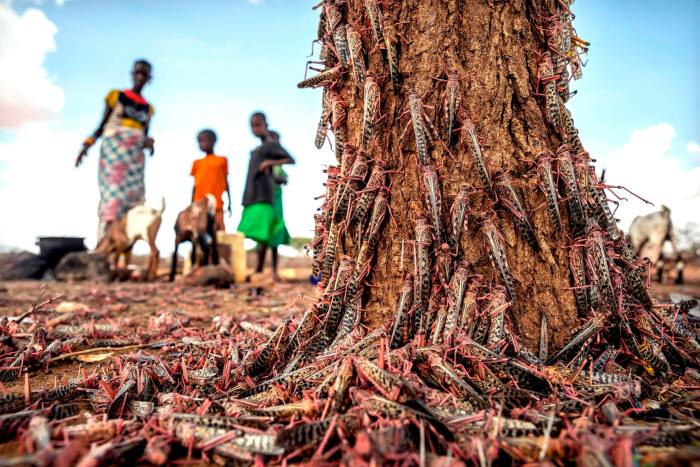
This article is an on-site version of our Moral Money newsletter. Sign up here to get the newsletter sent straight to your inbox.
Visit our Moral Money hub for all the latest ESG news, opinion and analysis from around the FT
Hello from Barcelona, where I’ve been attending the annual conference of the Principles for Responsible Investment — and bumping into a good number of Moral Money readers at the heaving venue. Returning after a Covid-enforced two-year hiatus, the conference has attracted a huge turnout of delegates from across the world’s major financial hubs — making clear the intense focus that global investors continue to place on questions of sustainable investment, “ESG backlash” be damned.
Which is not to say that the ESG backlash is running out of steam. Yesterday, Florida’s government announced that it would replace BlackRock as the manager of $2bn in state treasury funds, because “they have openly stated they’ve got other goals than producing returns”. With Florida governor Ron DeSantis now the most hotly tipped candidate to be the next US president — at least according to the betting markets — there are some real shadows hanging over the lively ESG discussions in Barcelona.
Today, I look at an interesting new announcement at the conference yesterday: a new investor collaboration to tackle human rights problems. And Kenza highlights an intriguing new opportunity for the insurance sector. See you on Monday. (Simon Mundy)
Being green isn’t enough, says new investor initiative
With 72 wind turbines generating up to 400MW of power, the Øyfjellet wind farm in northern Norway might look to many like an exciting new addition to one of the world’s greenest electrical grids. To local members of the indigenous Sámi people, it looks like a serious violation of their community’s rights — destroying valuable pasture for their reindeer and blocking an ancient migration route.
As the clean energy industry takes off — ushering in a new boom for the mining sector that serves it — it’s vital that human rights are not sidelined in the push for low-carbon power. That’s the logic behind a new collaborative initiative announced yesterday at the annual Principles for Responsible Investment conference.
Named “Advance”, it has been organised by the PRI and launched with an initial membership of about 220 institutional investors, managing roughly $30tn in assets. Smaller teams within the initiative will engage with 40 “initial focus” companies (which, for now, are all from the renewable energy or extractive industries) on social and human rights issues related to their operations.
You might think of it as a counterpart to the high-profile Climate Action 100+ investor movement — but focused on the ‘S’, rather than the ‘E’, of the environmental, social and governance agenda.
PRI chief executive David Atkin told me the CA100+ precedent had made clear which approaches to collaborative corporate engagement are effective — and which aren’t. “Now we’re in a position to take that model and apply it to a human rights programme.”
Members of Advance that I spoke to in Barcelona said that the new initiative was driven partly by concerns that the ESG agenda had become too narrowly focused on the first of those three pillars.
Tulia Machado-Helland, head of human rights at Storebrand — Norway’s largest private-sector asset manager — told me that many renewable energy companies did not yet fully understand the extent of the effects that their large projects could have on local communities. That accounted for the decision to focus on that sector, along with the mining industry, in this first wave of the Advance programme, she said.
Storebrand holds a stake in Eolus, the developer of Norway’s Øyfjellet wind farm, and has threatened to divest from the company unless it holds a proper consultation with the Sámi community.
In their engagement with companies on social issues to date, Machado-Helland said, investors had tended to be “reactive”, jumping to respond to individual scandals and disasters.
“But we haven’t advanced that much — you still have the same situations coming again and again,” Machado-Helland. “If we’re going to have a real lifting of a whole industry, you need to have a massive collaboration, [with investors] talking to the whole industry to lift the standard — so that these things don’t happen to start with.” (Simon Mundy)
What a locust swarm has to do with climate finance
Insurers have dealt with war, hurricanes and worsening cyber threats in recent years — so why not add plagues of locusts in east Africa to the mix?
Billions of the insects descended on Kenya, Ethiopia and Somalia two years ago, endangering food supplies across the continent as well as the livelihoods of farmers and herders.
The growing risk of pest infestations and other climate change-related disasters in Africa can damp foreign investors’ appetite for agricultural and forestry projects that already suffer from a shortage of overseas investment.
The solution could be nudging more insurers to underwrite the risks created by such disasters, according to the British government-funded investment agency, FSD Africa, which has a mandate to increase investment across the continent.

FSD has been working with the UK-based energy and climate risk finance company Parhelion to develop the capacity of African insurers like Nairobi-based ICEA Lion. The longer-term goal is to attract large reinsurers like Swiss Re and encourage asset management giants like Legal & General or BlackRock to invest in the continent.
“The role of insurance companies in de-risking investors’ balance sheets is really important and frees up lending capacity,” FSD’s chief executive Mark Napier told me.
Private investors and development banks typically only lend to riskier African projects if they are backed by a charitable donor or government guarantee, according to Napier. Expanding insurance coverage would unlock more risk capital and allow donor funds to be used elsewhere.
One specialised insurance product being developed by Parhelion covers local authorities and businesses for the cost of crop damage after a locust plague.
Another scheme builds insurance capacity for geothermal energy in Kenya and Ethiopia, a renewable source with the potential to provide power to 5mn people in the two countries. Growth in geothermal energy has been constrained by high upfront investment costs, as not all drilling leads to viable power production.
Insurance for developing countries was a hot topic at last month’s COP27, which saw the launch of the Global Shield initiative, spearheaded by the German government. A funding scheme for vulnerable nations backed by the G7 nations, it will act partly as an insurance fund to provide for a swift financial response after disasters.
The Global Shield launch followed last year’s Nairobi Declaration on Sustainable Insurance. It committed dozens of African insurers to promoting sustainable food and agriculture systems and engaging with governments on achieving the UN’s sustainable development goals.
Many insurers focus their sustainability efforts on backing tried-and-tested renewable energies like solar and wind, so it can be an uphill struggle to push them into riskier areas of coverage, such as carbon capture and storage, offsets and specialised products in developing countries, Parhelion’s founder Julian Richardson said.
“The insurance industry is very bad at research and development, and innovation. They are worried about loss”, Richardson said. “They think about how to withdraw cover rather than how to offer cover to green areas. It’s a very different philosophy.”
If pension funds and asset managers can gain the added security offered by insurance, some of these riskier asset classes in developing nations may be in line for much larger flows of capital. “Nothing gets invested unless it’s insured,” Richardson said. (Kenza Bryan)
Smart read
A new judgment from the European Court of Justice has made it harder to identify the real owners of companies and valuable assets, “much to the relief of oligarchs — and kleptocrats — under sanctions everywhere,” writes the FT editorial board.
Recommended newsletters for you
Due Diligence — Top stories from the world of corporate finance. Sign up here
Energy Source — Essential energy news, analysis and insider intelligence. Sign up here